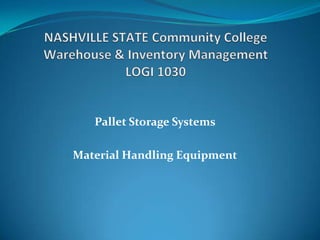Nashville state community college
- 1. Pallet Storage Systems Material Handling Equipment
- 2. Pallet Storage ï Block stacking: ï Stored on the floor ï Pallets are stacked on top of each other ï Stack ability and stack height are dependent on the following factors: Weight General stability SOPs/Safety/OSHA acceptable safety limits Floor lead restrictions Physical height availability Crush limits
- 3. Pallet Storage ï Block stacking: ï Use when retrieving product based on LIFO (Last In First Out) ï Not optimal for FIFO (First In First Out) ï Best for large number of pallets for same SKU, low cost, no racking
- 5. Pallet Storage ï Stacking Frames: ï Portable and collapsible frames ï Build as needed ï Steel uprights with steel decking ï Easy to collapse and storage is compact ï Use for loads/pallets that are unsafe to stack on top of each other
- 6. Pallet Storage ï Single-Deep Pallet Rack ï Permanent racking only one pallet deep ï Can store multiple SKUs in same column and row ï Best to be used with loads that are not stackable and SKUs with only a few pallets of product
- 8. Pallet Storage ï Double-deep pallet rack ï Permanent racking two pallets deep ï Use with SKUs with five pallets or more of product AND retrievals that are in multiple of two pallets ï Use with high volume SKUs ï Can save significant space over single-deep pallet racks
- 10. Pallet Storage ï Drive-In Rack: ï Able to drive into the rack ï Racks are up to ten pallets deep ï Pallets are stored on rails instead of decking ï Use with SKU quantities of five pallets or greater ï Best when have SKU totaling 20 pallets or more ï Downside, much slower production due to confined space
- 11. Drive-In Rack
- 12. Pallet Storage ï Pallet Flow Rack ï Similar to Drive-In Rack but has rollers on the rails ï Pallets are removed FIFO from the side opposite from which it was loaded ï As pallets are removed the remaining pallets roll forward ï Use with SKUs totaling ten pallets or more
- 13. Pallet Flow Rack
- 14. Pallet Storage ï Push Back Rack ï Similar to pallet flow rack ï Pallets are removed LIFO from the same side they are loaded ï Load new pallet by pushing existing pallets back ï Remove a pallet and the remaining pallets flow forward
- 15. Push Back Rack
- 16. Pallet Storage ï Mobile Pallet Rack ï Series of single deep racks abutted next to each other with no aisle in between ï Aisles are creating by pushing or cranking rows apart ï Upside: considerable space savings ï Downside: very slow production
- 18. Material Handling Equipment ï Walk Behind Pallet Jack ï May be manually operated or motorized ï Operate from a walking position ï Motorized versions may be capable of reaching low heights ï Best for short distance move
- 19. Material Handling Equipment ï Counterbalanced Lift Truck ï Lift truck with the weight on the back end to counter the weight of the load on the forks on the front end
- 20. Material Handling Equipment ï Straddle Truck: ï Instead of using counterbalance to provide stability, this truck uses outriggers to straddle the pallet.
- 21. Material Handling Equipment ï Side Loader: ï Loads from the side. Forks are located on the side not the front. ï Allows the operator to travel down the aisle without having to turn the truck to retrieve a pallet ï Downside: Can only reach one side of the aisle from a given direction of travel.
- 22. Side Loader
- 23. Material Handling Equipment ï Turret Truck ï Forks swing on the mast to either side ï Allows for more narrow aisle spacing
- 24. Material Handling Equipment ï Automated Storage Retrieval (ASR) ï Generally computer controlled ï Retrieval truck follows a computer controlled fixed path ï Storage locations consist of a matrix of fixed locations























